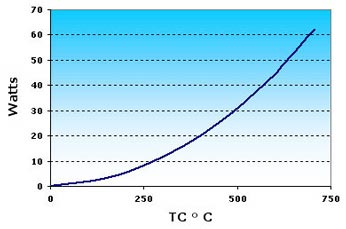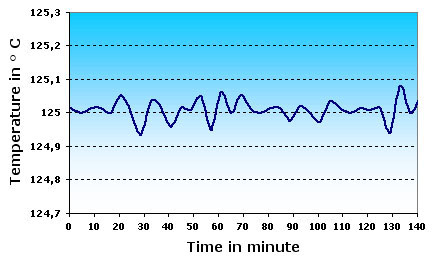Hot-Lip Cell: Low temperature cell
Please contact us to find the best suitable
model for your needs: webrequest@episerve.de
* Reduction of condensation at the crucible mouth 
* Excellent beam reproducibility and stability
* Avoids the blocking of the cell observed with
* materials like Zn, Te, Sb, Se, Pb, ZnTe, ZnS, PbTe...
* Hot zone: designed for temperatures
* under 700°C i.e. high vapor pressurematerials
* Inserts and special configurations for II-VI materials
* Compatible with most MBE systems
* Compatible with commonly used power units
* Optional integrated / cooling shutter
* Wide range of crucible capacities
* Modular design
* Double thermocouple
* Operating temperatures < 750°C
 A
standard effusion cell employs a single radiative heater element which surrounds
the crucible. Since the crucible is open only at one end, however, the temperature
is inhomogeneous along the central axis of the crucible and the temperature
can vary strongly (by hundreds of degrees celsius) between the bottom and
top of the crucible. As a result, considerable condensation is frequently
observed at the mouth of the crucible. The diameter of the crucible is thus
progressively reduced during the deposition process and can eventually become
completely blocked. This phenomenon is especially severe for high vapor
pressure materials which require low temperatures during operation
A
standard effusion cell employs a single radiative heater element which surrounds
the crucible. Since the crucible is open only at one end, however, the temperature
is inhomogeneous along the central axis of the crucible and the temperature
can vary strongly (by hundreds of degrees celsius) between the bottom and
top of the crucible. As a result, considerable condensation is frequently
observed at the mouth of the crucible. The diameter of the crucible is thus
progressively reduced during the deposition process and can eventually become
completely blocked. This phenomenon is especially severe for high vapor
pressure materials which require low temperatures during operation
Temperature stabililty of a LT-Effusion Cell @ 125°C
ADDON Innovation
ADDON low temperature (or HOT LIP) cells are designed with a hot zone at
the lip of the cell to combat the temperature gradient. This is achieved
through the combination of the hot zone geometry and heat shielding which
acts to reduce heat loss through the I.R. transparent crucible lip. This
design prevents recondensation
of materials at the mouth of the crucible and thus avoids the continuous
decrease of flux and change in spatial distribution associated with such
condensation. Temperature stability at low temperature is a very
important factor, as a slight change can produce a large difference in BEP
for high vapor pressure materials. This is especially true with II-VI elements
like CMT or ZnS/ZnSe compounds, in which a composition change of less than
1% can dramatically affect the electrical
and optical properties of the epilayers. Results obtained by ADDON designed
low temperature cells for long runs on thick CMT layers show very high stability
in temperature and flux distribution.
Inserts
For II-VI materials which often require very low evaporation temperatures,
it is sometimes necessary to use internal baffles in the crucible to improve
pressure/temperature conditions and avoid blocking. ADDON can advise you
on appropriate configurations and realize special configurations.
Compatibility
The cell comes in models fully compatible with existing systems manufactured
by Varian VG, EPI, Perkin-Elmer, Ulvac and Riber. Other versions are also
available (please provide us with details of flange size, connecting tube
and in-vacuum length).
Thermocouples
A double thermocouple is employed. Standard K type (Cr/A1) thermocouples
which have a relatively high e.m.f. are installed as standard because they
provide better stability at low temperatures (C type thermocouples or others
are also available upon request)
Specifications:
Filament: 1 filament
Maximum 0perating temperature: 750 °C
Maximum outgassing temperature: 850 °C
Temperature stability: better than +/- 0.1 °C
Thermocouples: Double C type (W Re 5/26%)
Minimum mounting flange: for crucible capacity 25 35 40 58 ccm 35CF / 70mm
/ 2.75", for crucible capacity 60 70 85 125 150 ccm 63CF / 114 mm /
4.5", Higher capacities on request
In-vacuum diameter: Crucible O.D plus 0.2 mm
In-vacuum length: 200 to 400 mm. (other on request)
Temperatures / power consumption: See curves
Power supply connectors: System or ADDON via universal UNIPLUG
Options: Other types of thermocouples,
Integrated cooling circuit, Integrated shutter, Inserts
copyright EpiServe GmbH 2017, all rights reserved